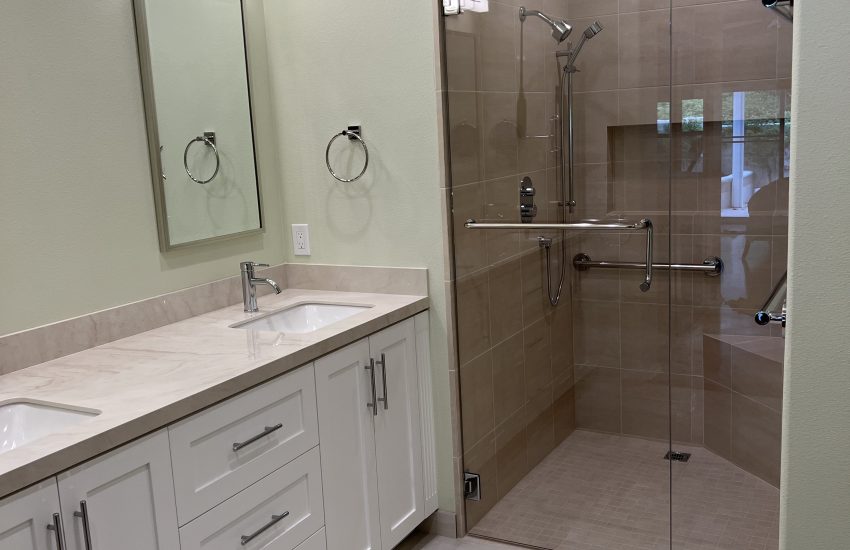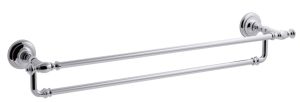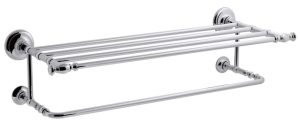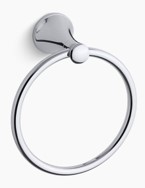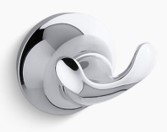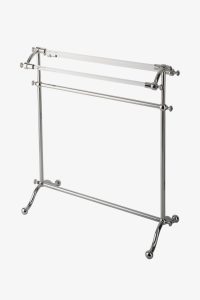Towel Bar
The towel bar style you pick for your bathroom remodel reflects your personality, style, and function. The towel bar needs to complement your new bathroom remodel but not be the focal point. You want the bar to become part of the overall “Wow!” effect but not be overbearing. Function, performance, and beauty are the trademarks of a great towel bar.
There are 3 towel bar styles. These are traditional, transitional, and contemporary.
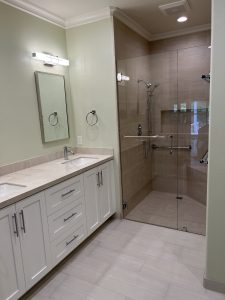 Many people confuse type with style. Type includes wall mounted, over the door, countertop, and floor standing. Type also refers to bar, ring, and hook. Traditional, transitional, and contemporary represent towel bar styles.
Many people confuse type with style. Type includes wall mounted, over the door, countertop, and floor standing. Type also refers to bar, ring, and hook. Traditional, transitional, and contemporary represent towel bar styles.
When considering towel bars for your bathroom, the key factor is who will be using the bathroom. A children’s bathroom has vastly different requirements than one used by an adult. For children, sturdy, durable, well connected and installed towel bars designed for drying and careless use are important.
Adult bathrooms emphasize style, durability, and firmly installed towel bars. Moreover, gender plays a role in towel bar consideration. In general, a woman needs someplace to hang three towels. One each for her body, hair, and floor mat. A man typically only uses one towel while bathing and a bathmat. Therefore, a traditional couple sharing a bathroom requires space for three to four towels.
Those with mobility concerns will want to consider towel bars that double as grab bars. These combine the strength of a grab bar with the functionality and beauty of a towel bar.
Let’s look at the 3 towel bar styles.
Traditional
 These have two posts and a round or square bar. The bar is slender and straight (no curvature). The simple yet elegant curves and lines are reminiscent of old-world design. There is plenty of distance between the posts to enjoy maximum space for towels. Traditional towel bars add visual impact without being overbearing. Traditional bars are distinguished by an elegant silhouette that easily adds grace and charm to your Victorian, French Country, Tudor, Craftsman, Colonial, Cottage, or Ranch style home.
These have two posts and a round or square bar. The bar is slender and straight (no curvature). The simple yet elegant curves and lines are reminiscent of old-world design. There is plenty of distance between the posts to enjoy maximum space for towels. Traditional towel bars add visual impact without being overbearing. Traditional bars are distinguished by an elegant silhouette that easily adds grace and charm to your Victorian, French Country, Tudor, Craftsman, Colonial, Cottage, or Ranch style home.
Transitional
 This style combines sculptured, fluid design lines with generous space for towels. Curved bars are a trademark of transitional design. Combining timeless vintage craftsman style with artisan design gives your bathroom space character and authenticity.
This style combines sculptured, fluid design lines with generous space for towels. Curved bars are a trademark of transitional design. Combining timeless vintage craftsman style with artisan design gives your bathroom space character and authenticity.
Transitional towel bars have clean lines with a soft midcentury modern style. These incorporate minimalism functionality to create dynamic beauty. Transitional bars work well in Victorian, Craftsman, Cape Cod, French Country, Colonial, Victorian, Tudor, Craftsman, Cottage, Ranch, and Mediterranean style homes.
Contemporary (or Modern)
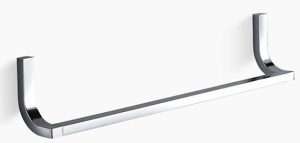 Contemporary towel bars use minimalistic lines. These lines are blended with precise angles and geometric forms to create a clean, versatile look. Incorporating subtly angled surfaces, these are designed for a modern chic look. A comparable traditional and transitional towel bar will fit the same size towel better than a contemporary towel bar. Why? The focus of contemporary is fashion over functionality.
Contemporary towel bars use minimalistic lines. These lines are blended with precise angles and geometric forms to create a clean, versatile look. Incorporating subtly angled surfaces, these are designed for a modern chic look. A comparable traditional and transitional towel bar will fit the same size towel better than a contemporary towel bar. Why? The focus of contemporary is fashion over functionality.
These bars are primarily designed for Contemporary style homes. They can also work in Cape Cod and Mediterranean style homes given the right design circumstances.
Towel Bar Sizes
Most are available in 18, 24, and 30-inch sizes. Contemporary bars typically offer a 12-inch size. Some manufacturers offer 36-inch towel bars. However, anything over 30-inches tends to look odd in most bathrooms. If more space is needed for towels, double bar, hotelier, and additional towel bars are best.
|
|
Towel Bar Types
Although this article is not about types, they should be mentioned briefly. There are four primary types. These are bar, ring, hook, and floor standing.
|
|
|
|
Towel bars are designed for everyday use. Quality bars are constructed for durability with superior finishes that will last for years without tarnishing or failing. Rings are for light, occasional, and decorative use. These work well in bathrooms that primarily serve guests or to create a touch of elegance. Hooks are excellent for hanging your towel for immediate accessibility after showering or steam bathing. Floor standing works best when wall space is limited, and extra towel storage is required.
How High Should a Towel Bar be Installed?
The average height should be 42-48 inches from the floor. Install hand towel rings 46-48 inches from the floor (20 inches from the countertop). In children’s bathrooms, 36 inches from the floor is ideal. As the child grows, you can move the bar higher. Install hooks between 60-70 inches from the floor. Towel size, especially length, is very important when considering where to install your towel bar. Do not install over lights, plugs, switches, and heaters.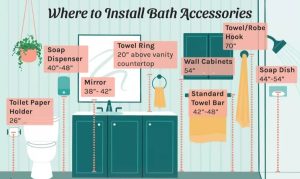
What Style Works Best for You?
The right towel bar for you will depend on your personal needs and bathroom space. When selecting a bar, space, performance, durability, and style are important considerations. Equally important is who will be using the towel bar. User size, age, and flexibility all matter.
Always Hire a Reliable and Dependable Contractor to Remodel your Bathroom
 Always work with a trustworthy contractor like DAD’s Construction. We are experts in bathroom remodeling who can manage projects in an efficient manner. DAD’s Construction will do everything to minimize the possibility of change orders. Our team will make sure we have all the necessary information to prepare a proposal that meets your requirements. Rest assured that we will provide you with a detailed, by line-item contract. We will make sure that the contents of this agreement are properly and clearly communicated to you. If you have questions or need updates regarding your project, we will always answer your inquiries.
Always work with a trustworthy contractor like DAD’s Construction. We are experts in bathroom remodeling who can manage projects in an efficient manner. DAD’s Construction will do everything to minimize the possibility of change orders. Our team will make sure we have all the necessary information to prepare a proposal that meets your requirements. Rest assured that we will provide you with a detailed, by line-item contract. We will make sure that the contents of this agreement are properly and clearly communicated to you. If you have questions or need updates regarding your project, we will always answer your inquiries.
How Can I Receive More Information on Remodeling my Bathroom?
If you would like more information on enjoying the best bathroom, kitchen, and interior remodeling experience in Orange County, call Dan at (949) 380-0177 or at dan@dadsconstruction.com for a free in home consultation. DAD’s serves all of South Orange County California. This includes Lake Forest, Mission Viejo, Foothill Ranch, Portola Hills, Ladera Ranch, Irvine, San Clemente, Dana Point, San Juan Capistrano, Rancho Santa Margarita, Coto de Caza, Dove Canyon, Laguna Niguel, Laguna Hills, Laguna Beach, Newport Beach, and Aliso Viejo.
